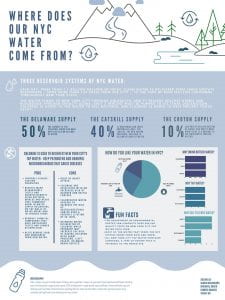WHERE DOES OUR NYC WATER COME FROM?
This is the order of how water flows in New York City, it is called the Empire of Water.
The Empire of Water: Mountain → Small Stream → Creek (the West-of-Hudson Watershed) The water leaves a reservoir → enters Catskill Aqueduct or the Delaware Aqueduct à flows down massive hundred-year old pipes to reservoirs in the East-of-Hudson Watershed in Putnam, Rockland and Westchester Counties → the Bronx → rest of the city.
New York City is the have the biggest public water supplier. Each day, more than 1 billion gallons of fresh, clean water is delivered from large upstate reservoirs. More than 90 percent of the city’s water supply comes from the Catskill/Delaware watershed, about 125 miles north of NYC; the other 10 percent comes from the Croton watershed or often a combination of all three.
The watershed sits on over a million acres, both publicly and privately owned, but highly regulated to make sure contaminants and toxics stay out of the water. The 92-mile Catskill Watercourse beneath the Hudson River is a century old. It can take up to a year for water to wind its way to the city from its origins in the countryside, through a network of tunnels, dams and reservoirs, traveling by gravity alone. It is said that “A $3.4 billion investment is planned over the next five years to shore up “decaying infrastructure.”
Although many New York residents gladly choose tap water at restaurants and praise the qualities of New York’s water, there are still pros and cons to the water in the city. We all wonder what makes New York City water actually taste so good? One of the sources stated “Thanks in part to the geology of the Catskill Mountains, which have very little limestone rock, the city’s water contains low levels of bitter-tasting calcium”. Another source states that “Chlorine is used to disinfect New York City tap water – keep pathogens and harmful microorganisms that cause diseases” However, there are pros and cons to chlorine used as a disinfect.
Pros:
- Controls disease-causing organisms
- Reduces many disagreeable tastes and odors
- Eliminates slime bacteria, moulds and algae that commonly grow in water supply reservoirs, on the walls of water mains and in storage tanks
- Removes chemical compounds that have unpleasant tastes and hinder disinfection
- Helps remove iron and manganese from raw water.
Cons:
- Risks of heart attack
- Chlorine are associated with an increased risk of bladder and rectal cancers.
- Chlorinated water appears to increase the risk of gastrointestinal cancer over a person’s lifetime by 50-100%.
- Drinking water disinfected by chlorine while pregnant may increase the risk of having children with heart problems, cleft palate, or major brain defects.
There are also a couple Interesting facts about the water in NYC:
- The Department of Environmental Protection conducts over 500,000 quality tests on New York City tap water each year. This not only ensures that the water tastes good, it also helps keep the water supply safe for all of the area’s residents.
- Most of the water that feeds the NYC system comes from rain and snow.
- All New York City tap water contains copepods, a type of shrimp that is invisible to the naked eye.
Regardless what people say about the NYC water system, it is still very impressive how these reservoirs can provide so much water through New York City’s water main system is a 6,800-mile expanse of iron and steel pipes for the people living in this state.
Bibliography:
https://www1.nyc.gov/site/dep/water/drinking-water.page
https://waterandhealth.org/safe-drinking-water/wp/
https://foodrevolution.org/blog/chlorine-water-harmful/
https://www.nrdc.org/experts/joan-leary-matthews/still-high-levels-lead-drinking-water-nyc-schools
Involvement in the team: creating the poster (illustrations and transforming information into an infographic)
![[ sustainable systems ] Field Research Poster](https://portfolio.newschool.edu/saskiawulandiarti/files/2019/09/where-does-our-nyc-water-come-from_-1.jpg)

